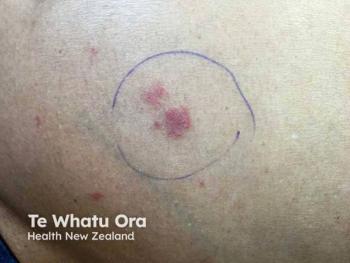
Upadacitinib Superior to Dupilumab in Atopic Dermatitis
The results from the Heads Up study were published in JAMA Dermatology, which demonstrated upadacitinib was superior to dupilumab in treating atopic dermatitis.
AbbVie announced that
Heads Up is a 24-week phase 3b mulitcenter, randomized, double-blind, double-dummy, active comparator-controlled study investigating the safety and efficacy of upadacitinib 30 mg, once daily versus dupilumab 300 mg, every other week for patients diagnosed with moderate to severe atopic dermatitis. Patients were randomized in each treatment arm and those treated with dupilumab received a 600 mg dose at baseline and every other week received 300 mg doses. All patients received placebo of the other treatment as part of the Heads Up double-dummy study design.
The primary endpoint of the study was the proportion of patients that achieved an Eczema Severity Index (EASI) score of 75 at week 16. The secondary endpoints were the percent change from baseline in the Worst Pruritus Numerical Rating Scale (NRS) at weeks 1, 4, and 16, the proportion of patients achieving EASI 100 and EASI 90 at week 16, the proportion of patients achieving EASI 75 at week 2, and the Worst Pruritus NRS (weekly average) improvement less than or equal to 4 at week 16. Other observed endpoints at week 24 included EASI 75, EASI 90, EASI 100 and improvement from baseline in Worst Pruritus NRS (weekly average).
This news comes after results from December 2020 that showed upadacitinib achieved superiority compared to dupilumab for the primary endpoint of the study with 71% of the upadacitinib arm achieving EASI 75 vs 61% of the dupilumab arm at week 16. There was also a significantly greater efficacy for upadacitinib for all secondary endpoints including itch and rates of skin clearance improvement compared to dupilumab.2
Results for select ranked secondary endpoints include:
- After 1 week of treatment, the upadacitinib 30 mg treatment group had a 31% reduction in itch compared to 9% in the dupilumab group.2
- After 2 weeks of treatment, 44% receiving upadacitinib achieved EASI 75 versus 18% receiving dupilumab.2
- At 16 weeks, 28% of people treated with upadacitinib achieved clear skin (EASI 100; p<0.001) and 61% achieved almost clear skin (EASI 90) compared to 8% and 39%, respectively, of those treated with dupilumab.2
"In this study, upadacitinib 30 mg demonstrated a more rapid onset of action compared to dupilumab, with patients experiencing a reduction in itch at 1 week and skin clearance improvements at 2 weeks. In addition, more upadacitinib-treated patients achieved high levels of skin clearance, such as EASI 90 and 100, by 16 weeks of treatment," said Andrew Blauvelt, MD, MBA, lead investigator for the Heads Up study and president of Oregon Medical Research Center in Portland, Oregon. "The results from this important comparative study will help inform how physicians work with their patients to set treatment goals for atopic dermatitis."
The safety profile for upadacitinib was consistent through the Measure Up 1, Measure Up 2 and AD Up phase 3 studies.2-4 The adverse events (AEs) that were most common through week 16 were acne in the upadacitinib arm and conjunctivitis in the dupilumab arm and serious AEs occurred in 2.9% of patients treated with upadacitinib vs 1.2% of dupilumab treated patients.2
Serious infections were 1.1% in those who received upadacitinib and 0.6% in those who received dupilumab.2 There was 1 treatment-emergent death due to bronchopneumonia associated with influenza A in a patient treated with upadacitinib.2 No malignancies were reported in the upadacitinib arm and 1 non-melanoma skin cancer was reported in the dupilumab arm.2 No major cardiac AEs or venous thromboembolic events were reported in either treatment arm.2
Reference:
1. Blauvelt A, Teixeira HD, Simpson EL, et al. Efficacy and safety of upadacitinib vs dupilumab in adults with moderate-to-severe atopic dermatitis: a randomized clinical trial. JAMA Dermatol. Published online August 4, 2021. doi:10.1001/jamadermatol.2021.3023
2. Blauvelt, A., et. al. A Phase 3 Trial of Upadacitinib Versus Dupilumab in Atopic Dermatitis. JAMA Dermatology doi: 10.1001/jamadermatol.2021.3023
3. Guttman-Yassky E, Teixeira HD, Simpson EL, et al. Once-daily upadacitinib versus placebo in adolescents and adults with moderate-to-severe atopic dermatitis (Measure up 1 and measure up 2): results from two replicate double-blind, randomized controlled phase 3 trials. The Lancet. 2021;397(10290):2151-2168. doi:10.1016/S0140-6736(21)00588-2
4. Reich K., et al. Safety and efficacy of upadacitinib in combination with topical corticosteroids in adolescents and adults with moderate-to-severe atopic dermatitis (AD Up): results from a randomized, double-blind, placebo-controlled phase 3 trial. Lancet. doi:10.1016/s0140-6736(21)00589-4.
Newsletter
Like what you’re reading? Subscribe to Dermatology Times for weekly updates on therapies, innovations, and real-world practice tips.


















